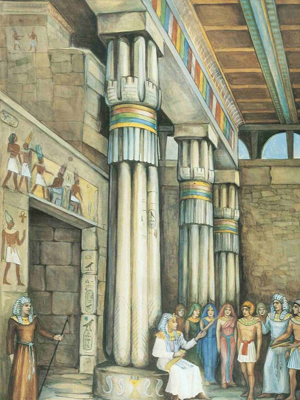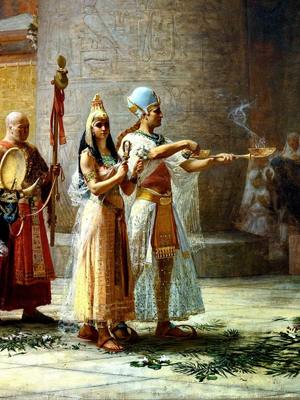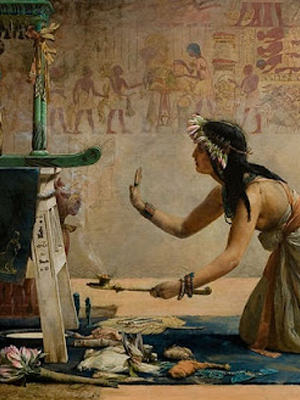Masonic Articles and Essays
Theurgy - Part I
Very Illus..... Bro... Kristine Wilson-Slack 33°
Date Published:
1/24/2024
Masonry has been described as "a system of morality, veiled in allegory and illustrated by symbols" but this definition is not adequate to fully describe the ritual beauty and magical power of its Rite. For that we must turn to a study of Theurgy, a form of ceremonial magic as old as civilization itself. What is Theurgy and what can it teach us of the inner or hidden side of Freemasonry?
 “The sun god (Atum) Ra was described as the ba which “came forth from Nun,” the ba “which Nun created.” In these terms, the ba is a potentiality which is actualized. According to these statements, Chaos produced Order. Nun, primordial Chaos, generated the god (Atum) Ra who then made the ordered cosmos. This is actually extremely similar to science’s version of Big Bang theory. Randomness – primordial Chaos, formlessness or non-existence (non-being) – miraculously produced its opposite: a formed, ordered cosmos. In truth, science hasn’t moved on at all from Egyptian mythology. It has no better explanation for how the cosmos was produced than ancient Egyptian priests spinning mythological webs did.”
“The sun god (Atum) Ra was described as the ba which “came forth from Nun,” the ba “which Nun created.” In these terms, the ba is a potentiality which is actualized. According to these statements, Chaos produced Order. Nun, primordial Chaos, generated the god (Atum) Ra who then made the ordered cosmos. This is actually extremely similar to science’s version of Big Bang theory. Randomness – primordial Chaos, formlessness or non-existence (non-being) – miraculously produced its opposite: a formed, ordered cosmos. In truth, science hasn’t moved on at all from Egyptian mythology. It has no better explanation for how the cosmos was produced than ancient Egyptian priests spinning mythological webs did.”
- Think Like an Egyptian: How the Ancient Mind Worked – Steve Maddison
This Egyptian myth of creation is not often repeated, and it has no name, but its theme of the power of divine magic and duality is, I believe, a principal narrative on the path of humanity’s perfecting. To understand this beginning, we first need to comprehend humanity’s early understanding of the word “divinity” and the word “magic.” To the Egyptians, most especially in the Old and Middle Kingdoms, these two words were synonymous. Magic is the power of divine creation, although its characteristics were not defined in any translated texts. In the creation, noted in the quote above, what was not noted was that in attendance at this divine birth was the god Heka. Heka was considered the power, omnipotence, and wisdom, that allowed Atum Ra to manifest. Thus, Heka and heka meant the same thing: divine magic.
“I am he whom the Lord of all (Atum or Ra) made before duality had yet come into being … the son of him who gave birth to the universe … I am the protection of that which the Lord of all has ordained … I am he who gave life to the Ennead of the gods … come to take my position that I may receive my dignity. Because to me belonged the universe before you gods had come into being. You have come afterwards because I am Heka.”
This fusing between the concepts of magic and divinity is a state that the modern mind, with its baggage of the past three thousand years, cannot quite grasp. “To appreciate the Egyptian view of magic, we need to accept that to the Egyptians magic was not considered strange or eccentric, but a part of daily life, to which everyone resorted. Magic blended seamlessly with religion and medicine, being seen as part of a holistic worldview.”
 An example of this mingling is the Egyptian Book of the Dead or The Book of Going Forth By Day. These papyrus scrolls were placed in the sarcophaguses of the dead so they could accurately recite the necessary spells and invocations to commune with the gods and to make the appropriate responses necessary to ferry their souls toward the afterlife. Spells in this context should not be interpreted as working to further personal gain or create a materialistic outcome; these were ritual texts set as guides to enable the dead to converse with the gods and goddesses and progress the human soul toward its journey to support the continuation of the world. The Egyptians did not see the realm of death, the Duat, as separate from the earthly realm, insomuch as they are one “world” to be traveled. Both realms were inhabited by the gods and their intermediaries. The only difference is that one involved a body and the other did not.
An example of this mingling is the Egyptian Book of the Dead or The Book of Going Forth By Day. These papyrus scrolls were placed in the sarcophaguses of the dead so they could accurately recite the necessary spells and invocations to commune with the gods and to make the appropriate responses necessary to ferry their souls toward the afterlife. Spells in this context should not be interpreted as working to further personal gain or create a materialistic outcome; these were ritual texts set as guides to enable the dead to converse with the gods and goddesses and progress the human soul toward its journey to support the continuation of the world. The Egyptians did not see the realm of death, the Duat, as separate from the earthly realm, insomuch as they are one “world” to be traveled. Both realms were inhabited by the gods and their intermediaries. The only difference is that one involved a body and the other did not.
These funerary texts were created around 5000 years ago, and were in use up through the Hellenistic period, throughout Egypt and northern Africa. One might say we’ve “gone past the need for that kind of thinking.” However, it seems that to understand the genesis of magic in our present construct of Freemasonry, we must understand the syncretic traditions that have been incorporated into our rituals. To understand where we are starting with the idea of “magic,” we need to be aware that to the ancient human mind, magic and divinity were one and the same.
What is the magic we see within Freemasonry? To understand this, we must really look at Freemasonry’s mission and purpose. To call Universal Freemasonry an esoteric Masonry would be very fitting. Indeed, the Universal Freemasonry website (https://universalfreemasonry.org) has a statement about Esoteric Freemasonry:
Esoteric Freemasonry is not mere speculation or frivolous imaginings; it is the fulfillment of the work that Freemasonry itself charges us with. Our work is the creation of a Universal Religion, a solid foundation upon which all human beings can build. This can only be done in unity and the keys to this unity can be found just beyond the gates that are guarded by the symbols of Freemasonry.
To break this down, and for the purposes here of discussing the magic involved in Freemasonry, we can say that Esoteric Freemasonry has three unique and specific objectives:
- Awaken the unused and underdeveloped inner human abilities, so its adherents can understand the symbols, allegory, and patterns delivered in its ritual.
- Teach its adherents about the cycles of life and death, in their small world and the universe as a whole, through the process of katabasis.
- Stress the importance of the unity of humans and divinity, which is known as henosis, the product of anabasis. (author amended, de Biasi, 2023)
These objectives or aims are not done in any particular order or fashion but are developed through the years of working together in a Lodge, where the ritual is taken seriously and executed with thought. Development takes place through contemplation of symbols and using theurgy (Greek, “god-working”).
 Theurgy is also known as divine or ceremonial magic. Theurgy may be seen as the framework of our Masonic ritual. The lessons contained in these three objectives of Esoteric Freemasonry are cyclic in nature, much like the upward spiral we see within King Solomon’s Temple. Thus, they cannot be learned in a linear stream but by repeated trials and approbations.
Theurgy is also known as divine or ceremonial magic. Theurgy may be seen as the framework of our Masonic ritual. The lessons contained in these three objectives of Esoteric Freemasonry are cyclic in nature, much like the upward spiral we see within King Solomon’s Temple. Thus, they cannot be learned in a linear stream but by repeated trials and approbations.
As we move through this series, it will be important to remember that the modern mind and the ancient mind do not think the same way about cosmology. As Esoteric Freemasonry is built on many traditions, including theurgy, it is important to remember the distinction in the way of thought. From Oxford, we have this definition of theurgy:
- "The operation or effect of a supernatural or divine agency in human affairs; A system of white magic practices by the early Neoplatonists."
We will see in Part Two how the history of Freemasonry is infused with theurgy, in much the same way that the ancient world is infused with magic in everyday life.
More Masonic Articles
Explore articles and essays written by Freemasons about Freemasonry.
Read More
Membership
Interested in becoming a member of the worlds oldest Fraternal organization?
Read More